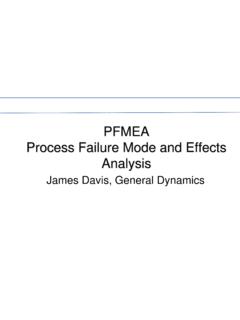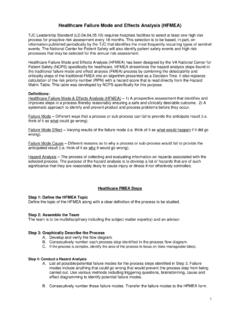Transcription of PREFERRED RELIABILITY PRACTICES FAILURE MODES, …
1 PRACTICE NO. PD-AP-1307 PREFERREDPAGE 1 OF 2 RELIABILITYPRACTICES FAILURE MODES, EFFECTS ANDCRITICALITY analysis ( fmeca )JETPROPULSIONLABORATORYP ractice:Analyze all systems to identify potential FAILURE modes by using a systematic study starting at the piecepart or circuit functional block level and working up through assemblies and subsystems. Requireformal project acceptance of any residual system risk identified by this :The fmeca process identifies mission critical FAILURE modes and thereby precipitates formalacknowledgment of the risk to the project and provides an impetus for design that Certified Usage:Viking, Voyager, Magellan, GalileoCenter to Contact for More Information:Jet Propulsion Laboratory (JPL)Implementation Method:Through the use of formal spread sheets, each potential FAILURE within an assembly is recordedtogether with its resultant assembly, subsystem, and system effect .
2 The severity of the system failureeffect is assigned from a pre-defined list ranging from "negligible effect " to "mission catastrophic."Design alterations can be made at the circuit level (thereby modifying the assembly level) to eliminatea FAILURE mode or to reduce its severity. The remaining failures are evaluated as potential subsystemfailures by accounting for possible redundancy or work-arounds. Again design alterations may beinvoked. Those remaining up to the system level are reported as single points of FAILURE (SPFs), andthe project makes a conscious decision to either retain them or to initiate corrective Rationale:Every technical mission carries with it a degree of risk. A mechanism is needed to identify andquantify the risk to permit decisions to be made which will ultimately reduce the risk to the minimumpermissible level within the project cost, schedule, and performance constraints.
3 Because mostspacecraft systems are extremely complex, a method of risk identification must be used which hastotal visibility into the system. The fmeca has been recognized as such an approach and, ifimplemented rigorously, will provide the necessary process requires the assumption of a FAILURE of each part of each unit. Thecredible FAILURE modes are identified for each part ( , capacitors can short oropen). If a piece part level fmeca is required by project definition, a line itemmust be entered for each identified mode of each part, , "C23 shorts". If aPRACTICE NO. PD-AP-1307 PAGE 2 OF 2 FAILURE MODES, EFFECTS AND CRITICALITYANALYSIS ( fmeca )project employs a high degree of redundancy, the complexity of a part level fmeca is unnecessarybecause a presumably redundant element will perform the function.
4 Thus a functional level FMECAis adequate, , "the amplifier chain formed by Q14, Q15, and Q16 and their associated parts hasvery low gain". This FAILURE may have many root part FAILURE causes but if all possible FAILURE modesof the block are identified, , "low gain, oscillation, high gain, high harmonic distortion", there isno value in recording the individual part causes. The most essential analysis in a design which usesredundancy is that of the cross-strapping networks. For this reason, a parts level fmeca isconsidered mandatory for all cross-strapped redundant elements, either inside an assembly or at anexternal of Non-Compliance:Without a formal fmeca process, the system design integrity would be determined by theexperience and rigor of a large number of individual design engineers.
5 There would be no means ofverifying that design risk has been minimized to a degree which yields a high confidence in achievingthe mission goals.






